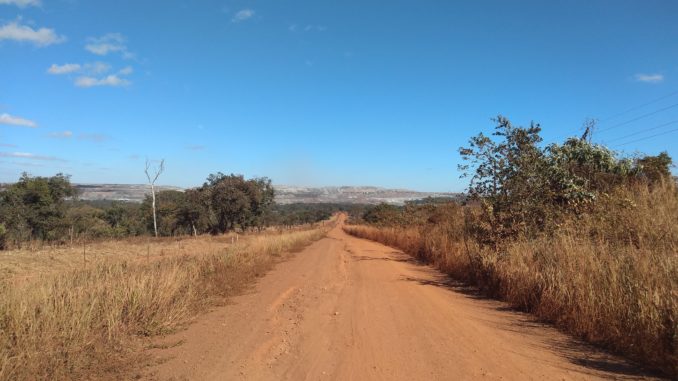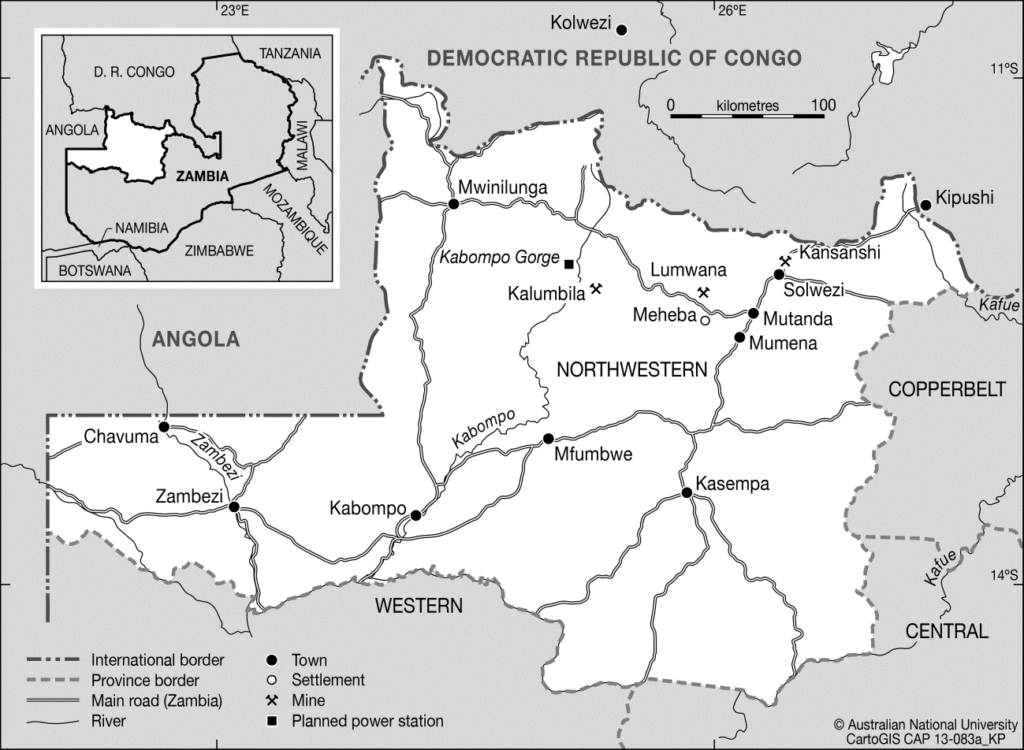
Margaret O’Callaghan is the author of the forthcoming publication “Copperfields”, which describes the first decade of the North-Western province mining boom. She delivered a paper on this topic to the University of Oxford-University of Lubumbashi ‘Comparaison de la Copperbelt’ conference held in July 2019.

Zambia’s North-Western province lies about 200 kms west of the Zambian Copperbelt and borders Katanga. It used to be a quiet rural area with a widespread, low density population. Since the year 2002, enabled by the dramatic increase in the price of minerals, large-scale mining in the province developed rapidly, starting with the revival by First Quantum Minerals Ltd (FQML) of the old Kansanshi mine located about 15 kms from the DRC border on the edge of Solwezi town. Further west Lumwana (then Equinox, now Barrick Gold) opened in 2005 and was followed in 2010 by Kalumbila mine (FQML) (see map). These are all major operations, mostly focussed on copper, but also producing some cobalt, gold and nickel and, as a side-product at Lumwana, uranium bearing ores. These developments occurred despite there being no rail infrastructure, little electricity, few local skilled workers, low-grade copper and the long distance between the mines and global markets.
Although some observers labelled it as such (see blog post by Robby Kapesa, 15 January 2019) the North West is NOT ‘the new Copperbelt’. It should be characterised and understood differently, because this nomenclature raises unrealistic expectations and is factually incorrect for the following reasons. Firstly, it is geologically distinct: its mineral deposits are comparatively low grade and dispersed into ‘fields’ rather than spread out in a ‘belt’ formation – which has implications for their profitable exploitation, especially if mineral prices are low (see Map 2).

Secondly, calling it the ‘New Copperbelt’ creates expectations which are unrealistic in the current privatized era. In 2008 the then Bishop of Solwezi, Dr Alick Banda, declared at the North West Mining Watch meeting: “We cannot over-state the distinct situation of the mining sector and of local communities in North Western Province, as compared to the Copperbelt.” He added that we should “…not fail to keep one ear attuned to those lessons learnt from the experience of the Copperbelt that may be of assistance.” But the myth persisted. Eight years later Matt Pascall, a FQML Director, was fed up with this misinterpretation. He stated in the ‘Bulletin and Record’ that “There is a lingering sentimentality in Zambia which tends to see the ‘good old days’ of the nationalized mining industry through rose-tinted lenses.” Such sentiments have flavoured attitudes in the North-West over the past decade, among both those who remember the old days, and those who think they do. Unrealistic expectations have created anger that today’s mining companies have not provided the same type of benefits, including comprehensive social welfare services and facilities which characterized the Copperbelt under ZCCM and during the late colonial period.
The North-West is different to the Copperbelt in other respects: the mines are all open cast and (largely) new, using the latest in technology and don’t have to manage ‘legacy’ issues. i.e. historical pollution, old machinery, dangerous underground pits etc. Consequently, the new mines are safer and require fewer workers. Whereas the old Copperbelt mines owned vast areas of land and carefully managed access to them, the areas surrounding North-West mines are government and customary land and not closely policed. Nor are all workers housed by the mines as they used to be in the Copperbelt.
There has been an uncontrolled influx into North-Western Province of job-seeking outsiders (many who remained unemployed), with the Solwezi town population increasing from about 70,000 in 2000 to about 266,000 in 2016. Many reside in informal shanty towns and the growing population has overwhelmed local services. There is a widespread belief that a much larger percentage of the taxes paid by the companies to the national government should be returned to the province to help it cope.
Another difference is that the new mining boom has not been supported by the provision of much new infrastructure, as was historically the case. Despite ambitious plans, there is no railway: the nearest rail system ends in the Copperbelt town of Chingola, 180 kms away. Consequently, all construction materials, equipment, supplies and fuel have to be moved by road. The stream of mining trucks travelling south from Katanga through Zambia to various ports illustrate that the DRC mining industry is in the same position – and fuels the argument that a major investment in regional rail could be cost effective and a much safer option. However, the vested interests in the trucking industry would no doubt argue otherwise.
Although the new developments do not closely resemble the historical Zambian mining industry, they do have important links.to the current Copperbelt. The most obvious is that of labour, with a large influx of job-seekers arriving, especially from the Copperbelt. They appear to be predominantly Bemba speakers – which has generated local tensions because the new arrivals are generally better educated than the local population, and their work experience makes them more likely to obtain mine jobs. This development has political implications for potential changes in voting patterns, and also for trade unionism. In some ways the situation mirrors that which occurred on the colonial Copperbelt when the Bemba took on mine work instead of the local Lamba as the Kasai did in Katanga. The other major link with the Copperbelt has been a transfer of industrial goods and related services, including smelting, to or for the North-West, as well as the provision of food items.
As on the Copperbelt, the new mining boom created culture shock, tensions and much confusion in surrounding communities. It also produced unrealistic expectations as to whom the benefits would accrue and the degree to which mining could bestow instant modernization upon the province. Nonetheless, the mining boom has provided an increase in the number and variety of jobs, both within and without the mines, a large increase in housing, a major boost to the building industry and other business opportunities, including the provision of farm produce. These myriad activities have turned the previously quiet provincial capital of Solwezi into a lively, albeit ramshackle town.
The experiences of these new ‘Copperfields’ provide a new line of enquiry as to how a new Zambian mining boom impacts and its relationship to national level control, the Copperbelt and the international political economy.
